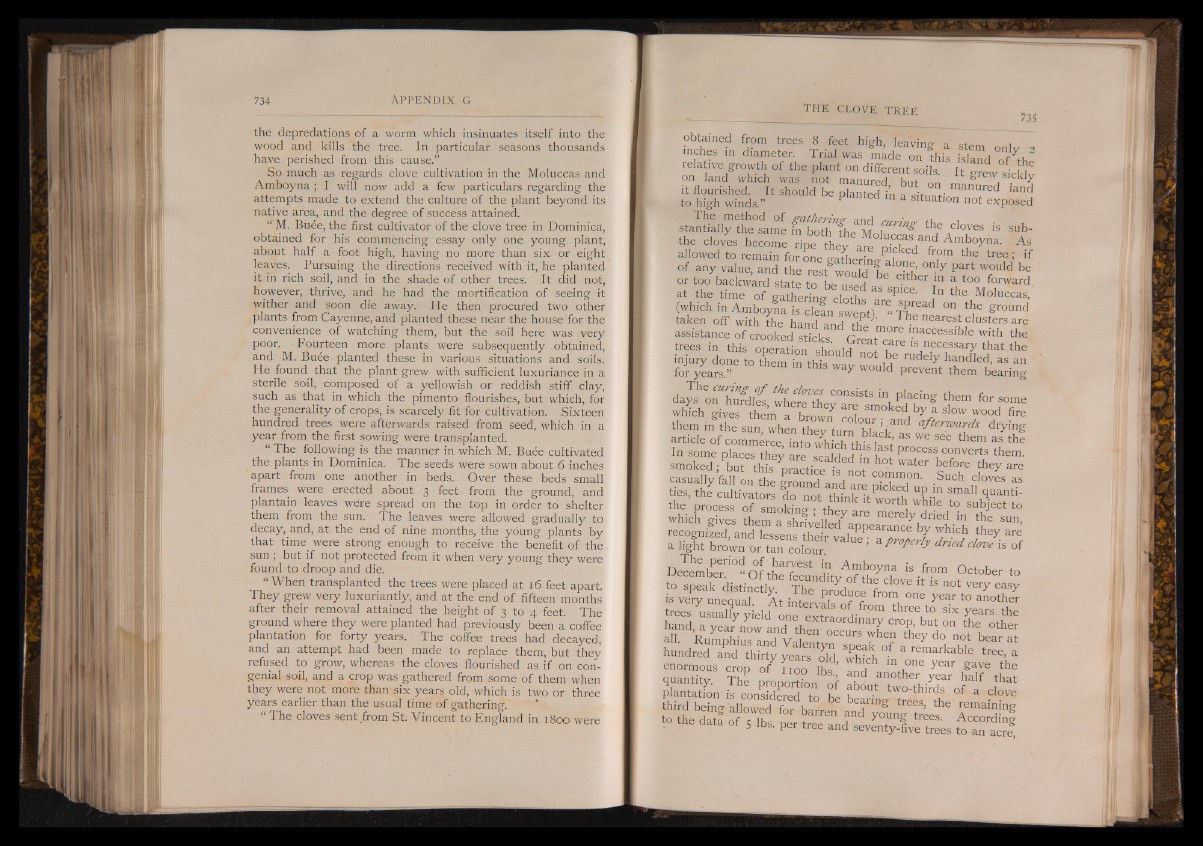
the depredations of a worm which insinuates itself into the
wood and kills the tree. In particular seasons thousands
have perished from this cause.”
So much as regards clove cultivation in the Moluccas and
Amboyna; I will now add a few particulars regarding the
attempts made to extend the culture of the plant beyond its
native area, and the degree of success attained.
“ M. Buée, the first cultivator of the clove tree in Dominica,
obtained for his commencing essay only one young plant,
about half a foot high, having no more than six or eight
leaves. Pursuing the directions received with it, he planted
it in rich soil, and in the shade of other trees. It did not,
however, thrive, and he had the mortification of seeing it
wither and soon die away. He then procured two other
plants from Cayenne, and planted these near the house for the
convenience of watching them, but the soil here was very
poor. Fourteen more plants were subsequently obtained,
and M. Buée planted these in various situations and soils.
He found that the plant grew with sufficient luxuriance in a
sterile soil, composed of a yellowish or reddish stiff clay,
such as that in which the pimento flourishes, but which, for
the generality of crops, is scarcely fit for cultivation. Sixteen
hundred trees were afterwards raised from seed, which in a
year from the first sowing were transplanted.
“ The following is the manner in which M. Buée cultivated
the plants in Dominica. The seeds were sown about 6 inches
apart from one another in beds. Over these beds small
frames were erected about 3 feet from the ground, and
plantain leaves wCre spread on the top in order to shelter
them from the sun. The leaves were allowed gradually to
decay, and, at the end of nine months, the young plants by
that time were strong enough to receive the benefit of the
sun ; but if not protected from it when very young they were
found to droop and die.
“ When transplanted the trees were placed at 16 feet apart.
They grew very luxuriantly, and at the end of fifteen months
after their removal attained the height of 3 to 4 feet. The
ground where they were planted had previously been a coffee
plantation for forty years. The coffee trees had decayed,
and an attempt had been made to replace them, but they
refused to grow, whereas the cloves flourished as if on congenial
soil, and a crop was gathered from ¿Some of them when
they were not more than six years old, which is two or three
years earlier than the usual time of gathering.
“ The cloves sent from St. Vincent to England in 1800 were
Th e c lo v e t r e e ^ .
obtained from trees 8 feet high, leaving- a stem
inches in diameter. Trial was made on this island o f7*-^
relative growth of the plant on different soils. It grew sickffi
on land which was not manured hnf ™ w sickly
it flourished. It should be planted in asffiiat' manured bad
to high winds.” P ln a sltuatlon not exposed
The method of gathering and curino- „1
stantially the same in both the Moluccaf a ^ d A T * ■ 'S SUa
the cloves become ripe thev are n T l / r Amboyna. As
allowed to remain for one gathering^) 1 * ? m the tree ' if
of any value, and the rest would he enn °n-y part WOuld be
or too backward state tn h e , a . ln a too forward
a t th e time o f cl„ S “ SP'Ce' T th e “ » '" « a s ,
(which in Amboyna is clean sweuf) I The . tI?e £round
taken off with the hand and rtf The nearest clusters are
assistance of crooked sticks C r& fm° re I.naccessibie with the
trees in this fe a tth e
injury done to them in this wav ° i f y handled, as an
for years.” Way WOuld Prevent them bearing
d a 'ysh ‘o n S f d lis S f * ‘V i T ’8' th em
which gives them a brnwrf ? smoked, by a slow wood fire
is very uneaual Af- fe fill i r r i Year to an°ther
S a tT o n i ^ n S T o 1 be a rin g ^ e s ' f f i ° f * ^